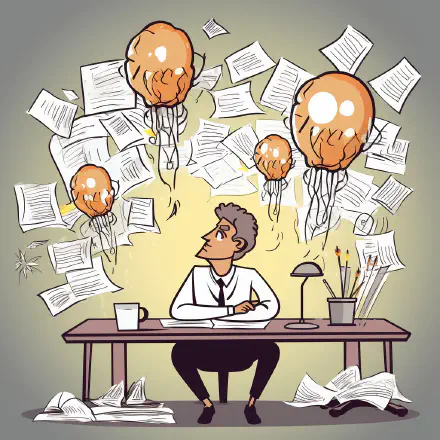
Introduction
Decision-making is an essential skill in everyday life. From deciding what to wear to work to choosing a career path, we are constantly making choices. The process of decision-making is not always straightforward and can be influenced by various factors such as emotions, personal values, and cognitive biases. Hence, understanding decision-making is crucial for making informed choices.
Studying decision-making is a multidisciplinary field that involves psychology, neuroscience, economics, and sociology. Scholars in these fields aim to understand how people make decisions, the factors that influence decision-making, and how to enhance our decision-making skills. By gaining insight into how decisions are made, we can make better choices that are more aligned with our goals and values.
Importance of Studying Decision-Making
Studying decision-making is important for several reasons. First, decision-making is an essential skill that affects our daily lives. We are constantly making choices that impact our well-being, happiness, and success. Second, understanding decision-making can help us make better choices. By being aware of the factors that influence our decisions, we can work towards reducing the impact of biases and emotions. Third, studying decision-making can help us understand how to persuade others. By understanding how decisions are made, we can develop more effective strategies for influencing the decisions of others.
In the following sections, we will explore different aspects of decision-making, including the process of decision-making, the science behind decision-making, theories of decision-making, applications of decision-making in real-life situations, and strategies for improving decision-making skills.
Understanding Decision-Making
Decision-making can be defined as the process of choosing a course of action from a set of alternative options that will lead to the desired outcome. It involves the selection of a choice that is expected to produce a favorable result. The decision-making process involves several stages, including problem identification, gathering information, evaluating the available options, making a decision, and implementing the chosen course of action.
Several factors can influence decision-making, including personal biases, emotions, experience, cultural and social influences, beliefs, and values. Emotions can influence decision-making by clouding judgment and leading to impulsive decisions. Personal biases can also distort the decision-making process by leading to errors in judgment or reasoning.
Understanding the process of decision-making is essential because it helps individuals make informed choices. It aids in identifying the factors that affect decision-making, enabling individuals to make decisions that are more rational and optimal. Furthermore, understanding the process of decision-making is essential in improving problem-solving and critical thinking skills.
According to psychologists, decision-making involves two types of thinking: intuitive and analytical. Intuitive thinking relies on instinct and emotion, while analytical thinking involves a process of evaluating the available options to make a logical decision. Analytical thinking is considered more rational and reliable than intuitive thinking.
In addition to the two types of thinking, there are two main approaches to decision-making: normative and descriptive. Normative decision-making is based on the assumption that decision-makers are rational and will choose the best option, given the available information and choices. Descriptive decision-making, on the other hand, examines how people make decisions in reality, considering real-world factors such as limited information and time constraints.
Overall, understanding the process of decision-making can help individuals make better choices by identifying the factors that affect decision-making and choosing a more rational approach to making decisions.
The Science behind Decision-Making
The human brain is responsible for the complex process of decision-making, and researchers have been studying the biological underpinnings behind decision-making for years. It is now understood that decision-making is not a simple process but rather a complex interplay between the cognitive, emotional and social parts of the brain. By understanding the science of decision-making, we can better equip ourselves to make decisions that are beneficial for us.
Role of neuroscience in studying decision-making
Neuroscience, the scientific study of the nervous system and brain, has greatly contributed to understanding decision-making. With advanced imaging techniques such as fMRI, researchers can now visualize the parts of the brain involved in decision-making. Moreover, these techniques have shed light on the changes that occur in the brain during the decision-making process, allowing researchers to identify the neural pathways responsible for decision-making.
Overview of brain regions involved in decision-making
The prefrontal cortex, a brain region associated with planning, decision-making, and goal-directed behavior, is central to the decision-making process. The dorsolateral prefrontal cortex is involved in decision making under conditions of uncertainty while the ventromedial prefrontal cortex is responsible for making decisions based on value. Additionally, the amygdala, the anterior cingulate cortex, and the insula, are all associated with decision-making under emotional or social contexts.
How emotions and cognitive biases affect decision-making
Emotions play a central role in decision-making, and they can either facilitate or impair our ability to make decisions. For instance, positive emotions like happiness and excitement can make us more impulsive in our decision-making, while negative emotions like fear or anxiety can lead to indecisiveness or avoidance. On the other hand, cognitive biases can lead to irrational decision-making, which can have detrimental effects on our well-being. Common cognitive biases include confirmation bias, availability heuristic, and anchoring bias.
In summary, the science of decision-making has greatly advanced our understanding of how the brain makes decisions. It has allowed us to identify the brain regions involved in the process, the changes that occur at the neural level, and the role of emotions and cognitive biases in the decision-making process. By becoming familiar with these findings, we can improve our decision-making abilities and make more effective decisions in our everyday lives.
Theories of Decision-Making
There are several theories that explain how individuals make decisions. These theories aim to understand why people make the choices they make and how their decisions are influenced by various factors.
Rational choice theory
Rational choice theory assumes that individuals make decisions that are rational and based on self-interest. According to this theory, individuals weigh the pros and cons of each option, calculate the costs and benefits, and select the option that maximizes their utility.
However, this theory has been criticized for being unrealistic, as it assumes that individuals have all the relevant information, have the ability to make accurate calculations, and make decisions that are consistent with their preferences.
Prospect theory
Prospect theory proposes that people make decisions based on how they perceive potential gains and losses rather than the final outcome. According to this theory, individuals are risk-averse when it comes to gains and risk-seeking when it comes to losses.
For instance, if offered a choice between receiving $50 or taking a gamble for a 50% chance of winning $100, most people would choose the first option. However, if given a choice between losing $50 or taking a gamble for a 50% chance of losing $100, most would choose the latter option.
Social cognitive theory
Social cognitive theory emphasizes the role of social and environmental factors in decision-making. According to this theory, individuals learn from observing their peers and the consequences of their actions, which shapes their attitudes and behaviors.
This theory suggests that decision-making is influenced by various factors such as culture, family, peer groups, and societal norms. For instance, an individual’s decision to smoke may be influenced by their friends who smoke or by advertisements portraying smoking as cool.
Overall, these theories help us understand how individuals make decisions and the various factors that influence their choices. By studying these theories, we can develop strategies to improve decision-making skills and make better choices in our everyday lives.
Applications of Decision-Making in Real-Life Situations
Decision-Making in Business
Decision-making is a crucial aspect of any successful business. It begins with determining the objectives, analyzing the alternatives, and selecting the best course of action that aligns with the goals of the organization. Business decision-making can take various forms, such as strategic decisions, operational decisions, and tactical decisions.
Strategic decisions are long-term decisions that shape the future of the organization. They include decisions such as mergers and acquisitions, product diversification, and market expansion. Operational decisions are the day-to-day decisions that ensure smooth running of activities in the organization. They encompass aspects such as production processes, inventory management, and staffing. Tactical decisions are short-term decisions that are made to address specific issues or challenges that may arise in the organization. Examples of tactical decisions include the implementation of a cost-cutting strategy or the resolution of a customer complaint.
Decision-Making in Healthcare
Healthcare decision-making involves patients, family members, healthcare providers, and policymakers. Patients make decisions about their health based on their beliefs, values, and preferences. Healthcare providers rely on clinical expertise and evidence-based practices to make decisions about patient care. Policymakers make decisions that impact the healthcare system, such as funding for research or development of health policies.
One of the most critical healthcare decisions is end-of-life care. Patients and family members must make decisions about how they want to receive care towards the end of life, such as do-not-resuscitate orders or hospice care. It is essential to involve patients and family members in decision-making to ensure that their preferences and values are respected.
Decision-Making in Personal Relationships
Decision-making plays a vital role in personal relationships. It involves individuals making choices in their relationships with others, whether it is romantic relationships, family relationships, or friendships. Important decisions include communication, resolving conflict, and trust-building.
For instance, in romantic relationships, couples must make decisions such as whether to move in together, have children, or get married. In family relationships, decisions may revolve around caregiving, education, and housing. In friendships, decisions may be made regarding how often to meet, whom to invite to social events, or how to support a friend going through a tough time.
Effective decision-making in personal relationships requires clear communication, mutual respect, and consideration for the other person’s feelings and needs. It is also essential to acknowledge that not all decisions will be easy, and compromise or seeking third-party guidance may be necessary.
“In a strong relationship, you should always try to consider your partner’s feelings, opinions, and preferences as much as you consider your own” - Oprah Winfrey
These three applications of decision-making demonstrate the importance of understanding the process and factors that influence decision-making. Being aware of various decision-making theories, such as rational choice theory, social cognitive theory, and prospect theory, can help individuals make informed choices that align with their values and goals.
Improving Decision-Making
Making good decisions is crucial to both personal and professional success. Individuals can enhance their decision-making skills in several ways, including:
1. Reflective Practice
One way to improve decision-making is through reflective practice. This process involves critically analyzing past decisions and identifying what went wrong and what went well. Through reflection, individuals gain insights into their decision-making processes and can improve their skills by adjusting their approach and strategies.
2. Gathering Information
Another way to improve decision-making is by gathering information. Researching and analyzing relevant information can provide a clear understanding of the situation and the available alternatives. By seeking out counsel from experts, individuals can gain new perspectives on the issue at hand, which can inform their decision.
3. Deliberation
Good deliberation is essential for making sound decisions. Taking time to weigh the pros and cons of different options can result in better outcomes. Weighing the consequences and potential benefits of each option can offer a clearer view of the best course of action in any situation.
4. Develop Emotional Awareness
Decision-making is not just about logic and reasoning; emotions can also play a significant role in the process. Being aware of one’s emotions and how they might be influencing decision-making is crucial. Developing emotional awareness can help an individual recognize when they are operating on an emotional level and help them to make a more rational decision.
5. Seek Suppo
Making important decisions can be daunting. Seeking support from a colleague, a trusted friend or relative can help an individual gain a different perspective and can enlighten them about other possible options.
6. Education and Training
Studies have shown that education and training can significantly improve one’s decision-making abilities. Individuals can take courses in decision-making to enhance their decision-making skills and become more aware of their biases and strategies that could be used to overcome them.
In conclusion, decision-making is a vital skill that can be improved through consistent practice and deliberate effort. By utilizing the techniques mentioned above, individuals can optimize their decision-making abilities and make informed, logical decisions that lead to personal and professional success.
Conclusion
In conclusion, the science of decision-making is an important and fascinating topic that has far-reaching implications for everyday life. By understanding the process of decision-making and the various factors that influence it, we can make better choices that lead to more positive outcomes.
Through the exploration of neuroscience, such as the brain regions involved in decision-making, we can gain insight into the intricacies of the decision-making process. Moreover, theories such as rational choice theory and prospect theory provide further frameworks for analyzing decision-making.
In real-life situations like business, healthcare, and personal relationships, decision-making plays a crucial role. Improved decision-making leads to more effective problem-solving and ultimately results in better outcomes.
To improve our decision-making skills, we can use various strategies such as seeking out education and resources, being aware of cognitive biases, and practicing decision-making in different contexts.
With further research and development in the science of decision-making, we can continue to expand our understanding and improve our ability to make well-informed decisions in our daily lives.
As we have seen, understanding decision-making has practical implications in a wide range of domains, making it an essential area of study that deserves more attention. By prioritizing the development of better decision-making skills, each of us can lead a more fulfilling and successful life.

